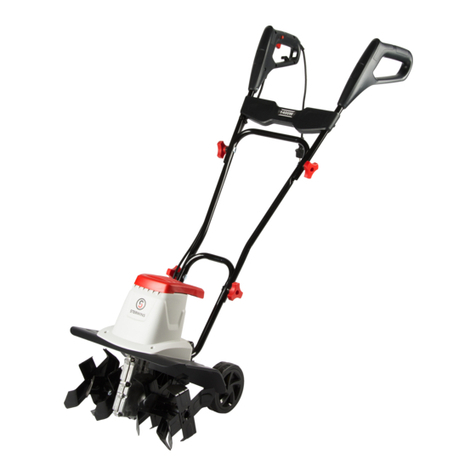
3. Non utilizzare la macchina nei terreni pietrosi. Lavorare solamente alla luce del giorno od in presenza di una buona illuminazione articiale.
4. All’avviamento o durante il lavoro non mettere le mani od i piedi vicino o sotto le parti in rotazione. Non mettere in moto la macchina quando
si é davanti alle frese. Tirando la funicella di avviamento del motore le frese non devono girare (se le le frese girano intervenire sul registro
di regolazione del tendicinghia).
5. Le frese in moto sono un pericolo per i piedi, durante il lavoro indossare sempre calzature resistenti e pantaloni lunghi. Non utilizzare la
macchina quando si è a piedi scalzi o si indossano dei sandali.
6. Per trasportare la macchina fermare il motore.
7. Tutte le operazioni di servizio devono essere effettuate con motore e frese non in movimento.
8. Non abbandonare la macchina con motore in moto.
9. Il conduttore deve operare rimanendo dietro la macchina. Camminare, non correre mai con la macchina.
10. In caso di urto contro un ostacolo che blocchi la macchina, farla controllare da una stazione di servizio.
11. E’ vietato avviare la macchina in locali chiusi .
12. AVVERTENZA: la benzina è altamente inammabile, conservare il carburante in appositi recipienti, fare il rifornimento (o lo svuotamento
del serbatoio) solamente all’aperto e non fumare durante l’operazione, rimettere sempre a posto correttamente i tappi del serbatoio e del
contenitore della benzina.
13. In caso di fuoriuscita della benzina, non tentare di avviare il motore ma allontanare la macchina dall’area dove è avvenuta la fuoriuscita
evitando di creare fonti di accensione nché non si sono dissipati i vapori di benzina.
14. Attenzione al tubo di scarico. Le parti vicine possono arrivare a 80°.
15. Lavorando in pendenza esercitare un estrema cautela nei cambi di direzione e comunque non lavorare su pendii eccessivamente ripidi,
accertarsi sempre dei propri punti d’appoggio.
16. Non modicare la taratura del regolatore della velocità di rotazione del motore o non far raggiungere al motore una condizione di
sopravvelocità.
17. Prima dell’uso procedere sempre ad un controllo visivo per assicurarsi che le lame non siano usurate o danneggiate. Sostituire per motivi
di sicurezza le lame e tutti gli altri organi che risultino danneggiati o usurati. Sostituire i silenziatori difettosi.
18. Facciamo presente che non ci assumiamo nessuna responsabilità per danni dovuti a: a) riparazioni effettuate da personale non
specializzato o da centri di assistenza non autorizzati, oppure b) impiego di RICAMBI NON ORIGINALI Per gli accessori si applicano le
stesse condizioni.
nIL LAVORO CON LA MOTOZAPPA La motozappa è concepita secondo il più moderno concetto della lavorazione biologica del terreno.
Non è consigliabile lavorare il terreno a grandi profondità per non danneggiare l’attività dei microorganismi. Il giardiniere ecologista sa che si deve
lavorare il terreno solo in supercie e, grazie a questa motozappa il lavoro si trasforma in attività piacevole. Questa macchina adatta alle piccole
superci e alle serre, fresa, sarchia ed elimina le erbe cattive. La forma delle frese è studiata per lavorare al meglio il terreno. Si può regolare la
profondità di lavoro con lo sperone (5 - 12 cm).
nTRASPORTO Per la movimentazione è previsto l’uso di carrello elevatore. Le forche, allargate al massimo consentito, vanno inserite negli
appositi spazi del pallet. La massa della macchina è indicata nella etichetta della marcatura e riportata nei dati tecnici. Tramite la ruota di trasferimento
(Fig. 1 part. E) è possibile portare la motozappa nella posizione di impiego in modo pratico e comodo. Prima di trasportare la macchina spegnere il
motore.
ITALIANO
2




























